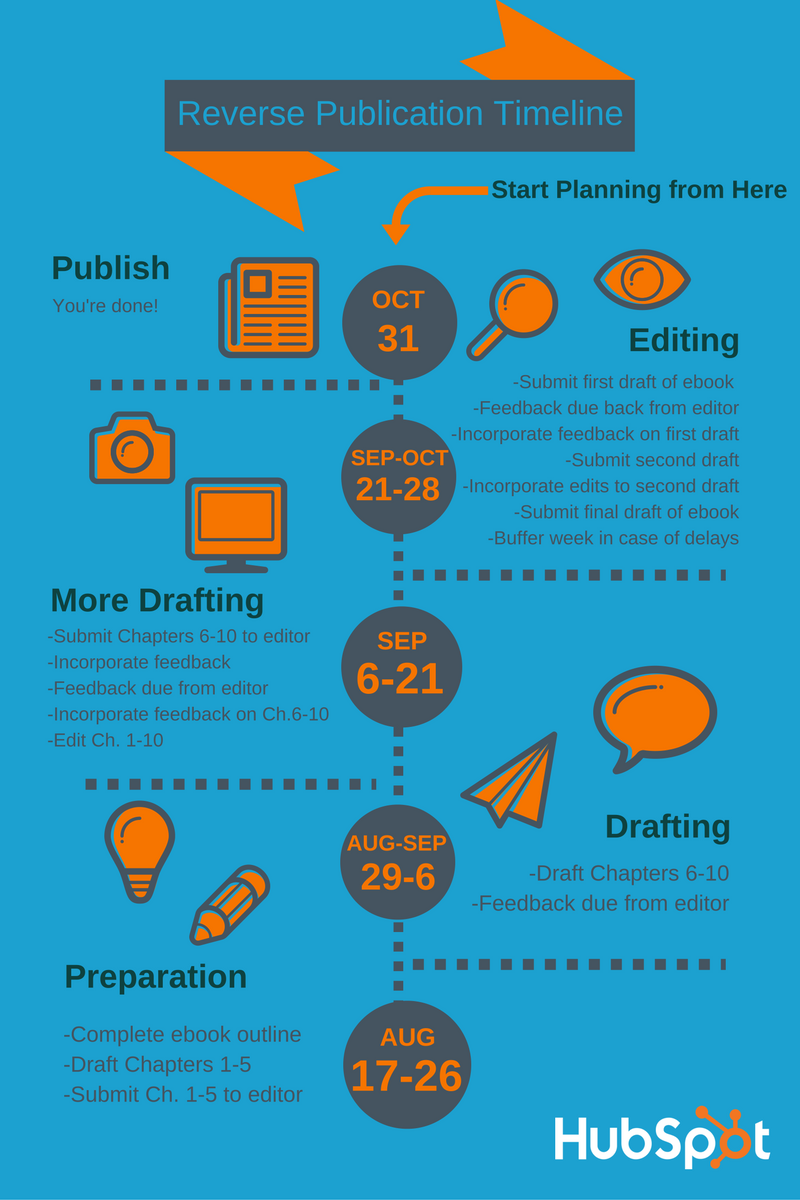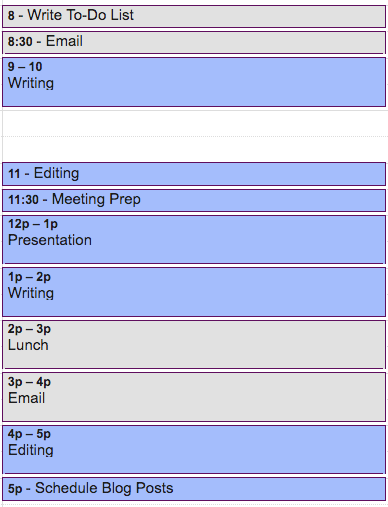
While intended to make life easier, sometimes putting together a to-do list can feel like a bigger undertaking than accomplishing the actual tasks at hand. This concept is referred to as the procrastination "doom loop" -- a cycle of putting off tasks, feeling anxiety and guilt, and consequently working with lower productivity and efficiency due to these negative feelings.
This is especially true when it comes to long-term projects, as it can be easy to lose focus and diligence when working toward monthly or quarterly deadlines. But when you're forced to work as your own project manager, organization is the name of the game.
8 Time Management Tips to Help You Hit Your Long-Term Deadlines
1) Set short-term SMART goals to benchmark your success, and don’t be afraid to adjust them.
If your long-term goal is months away, and the final product is the completion of a large project, such as an ebook publication or new product launch, short-term benchmarks for success will keep you on track and help you stay motivated and productive throughout the process.
We recommend setting SMART goals, which stands for:
Specific
Ensure that your short-term goals are as specific as your final goal. For example, instead of “work on ebook every day for three months,” set a specific goal to complete a certain amount of pages each week. Specific goals are easier to track and report on and more difficult to de-prioritize.
Measurable
Trackable goals allow you to measure your progress toward your final goal and report on your successes and challenges. If your long-term goal is to launch a social media campaign, a measurable short-term goal would be “secure one press mention per week” in lieu of “spread campaign awareness.”
Attainable
According to Harvard Business Review, being challenged is motivating, but working towards goals that you can’t reach is not. Establish goals that you can work to achieve and not be discouraged by. For example, it may not be attainable for your branded hashtag to start #trending on Twitter. Instead, you could aim to get a thought leader in your space to tweet using your hashtag to generate awareness on social media.
Realistic
When you’re strategizing for a big project, plan for the unexpected in the same way that you plan for success. Don’t be dishonest with yourself or your team about your daily productivity potential or how long different processes could take working toward the final goal. With eight hours in a typical workday, make sure you’re not biting off more than you can chew.
Time-Bound
Set mini-deadlines for yourself throughout the project timeline to give you a rough outline of what metrics you should be hitting each week. This approach helps break up your larger project into more achievable sections to prioritize. Balance your deadlines to provide you with motivation and some urgency, but if the deadline is too high-pressure and unrealistic, your creativity and productivity could actually diminish, based on results from a Harvard Business School study.
The key to setting these shorter-term benchmarks is flexibility, according to psychologist Tamar Chansky. Throughout your process, ensure that you are checking to ensure that these smaller goals are staying SMART -- with emphasis on “realistic.”
If you’re falling behind on a deadline or a process is proving more challenging than anticipated, adjust your measures of success to stay on-track.
2) Create a reverse to-do list for your projects.
When working on a deadline that is a month or more away, my favorite strategy for project management is a reverse to-do list, which I create by starting with my final, long-term deadline, then working backwards by building in milestones to complete during the process.
Here's an example of how I might use this approach when planning for an ebook launch:

It’s important to keep updating the deadlines and timeframes as your project evolves to account for any delays or unanticipated challenges to keep yourself on track.
Another key for making this a successful tool is building buffer time into your mini-deadlines to account for those delays. Even if it doesn’t normally take you a full week to incorporate edits, building extra days into each mini-deadline will ensure that your final deadline isn’t delayed by obstacles earlier in the process.
These mini-deadlines help promote prioritization of important tasks and prevent burnout, according to Harvard Business Review.
3) Create accountability for yourself.
You may be responsible for keeping track of your progress toward achieving your goal, and holding yourself accountable to the timelines and benchmarks you've established will help you stay motivated and positive at work.
Personal accountability leads to increased feelings of workplace satisfaction, creativity, and innovation, and there are a few ways to promote that while working on your long-term project, including:
- Sharing progress toward goals with others. For some people, being vocal about your goals and progress can make a huge difference. For example, one study found that participants in weight-loss programs are more motivated and likely to succeed if they share progress photos on social media.
- Setting up a personal reward system for each benchmark you achieve on the path to project completion. Our brains are wired to be more productive the more we achieve goals and reward ourselves, so be sure to keep progress benchmarks short-term and realistic.
- Tracking your progress so you can visualize what portion of your project you've successfully completed. Measuring progress helps you to evaluate your weaknesses, celebrate your strengths, and see the bigger picture of how your project is unfolding.
- Being honest with yourself and your colleagues about your achievements. If you're transparent about what you are (or aren't) able to achieve in a given timeframe, your experience will inform future strategy for long-term projects. This may take the shape of an informal conversation or an official performance review; in any case, be positive, focus on your achievements, and maintaining a growth mindset about your weaknesses to continually identify ways to improve and continue to excel.
4) Use a responsive to-do list.
If you’re working on a deadline that’s months away, flexibility is a must. You’ll need to be able to multitask, re-prioritize, and press pause on one piece of your project to focus on another depending on your organization’s needs. Responsive to-do lists and organizational tools are helpful ways to keep track of the various elements of a long-term project and to track daily, weekly, and monthly priorities all in one place. Check out tools that allow you to customize different types of lists, such as:
- Asana allows teams to create collaborative to-do lists and project management lists (Free for up to 15 users; Premium available for $8.33/member/month)
- Trello allows users to customize the names of their to-do lists, share them among their team members, and assign them to different people using due dates (Free for Basic; $9.99/user/month for Business Class; $20.83/user/year for Enterprise)
- todoist allows users to share unlimited tasks with colleagues and edit to-do lists offline (Free for Basic; $29/year for Premium)
- Google Keep is a digital sticky-note system that syncs to Google Drive (Free)
5) Create a schedule where you can be most productive.
Adam Rogers suggests finding your “biological prime time,” as coined by Sam Carpenter, author of Work the System, as key to becoming a more productive writer. This time can vary from person to person, but according to the Harvard Business Review, many traditional work schedules go against our natural circadian sleep rhythms that determine our peak and low energy levels.
Researcher Christopher Barnes learned that workers typically approach peak productivity around 12 p.m. and experience a sharp decline at roughly 3 p.m.. Towards the end of the afternoon, energy starts to return again, with another peak around 6 p.m..
The lesson here? Plan your most important tasks around these energy peaks, and your least important tasks around these lows. Barnes notes that this is not typical of many workers, who spend their mornings responding to emails and completing other administrative tasks, but who don’t start tackling bigger challenges requiring high levels of productivity until they have already missed their 12 p.m. peak and begun approaching the 3 p.m. slump.
Try to create a daily schedule that allows you to get the most out of your high-energy times, and if it operates contrary to the rest of your organization, communicate that with your supervisor.
In the example calendar below, events requiring higher levels of productivity and cognitive thought, such as meetings, presentations, and writing, are scheduled around peak productivity times. In contrast, answering emails and eating lunch are scheduled near productivity dips because, unless the emails are time-sensitive, these to-dos aren't typically top-priority and can be scheduled around bigger tasks.

This isn't an exact science, so finding your ideal schedule may require some testing to determine when you're most efficient and when you hit that afternoon slump.
6) Ask for help when you need it.
This is necessary advice for anyone working on a team, as using resources around you is integral to most workplace success, according to Fortune. If you’re being tripped up by an obstacle, are experiencing a production delay, or simply have writer’s block that could throw a wrench in your timeline, and you should use resources around you for guidance and assistance.
This is particularly essential if your deadlines are for finished products months in advance. Missing one internal mini-deadline probably won’t be an insurmountable issue, but if you’re consistently falling behind on benchmarks towards the final goal, staying silent and trying to fix the problem yourself could result in a missed deadline.
Don’t be afraid to reach out to peers or managers for help with brainstorming, editing, or any other roadblock you might be encountering. They would rather you reached out for help before missing a deadline than after missing a deadline, and remember: the most successful people ask for help.
Lean on resources around you to make your life easier and your project better, but remember to be a good coworker, too. When you're asking for help:
- Outline your SMART goals so your colleagues understand your project.
- Provide them with resources, such as project specs or prior drafts, to make it easier to help you.
- Be specific about what you're asking for and when your deadlines are.
- Say thank you! Acknowledge their above-and-beyond efforts by letting their supervisor know how they collaborated with you and offering to return the favor with one of their projects.
- Offer help to colleagues on a regular basis, not just when you need help, to cultivate good faith in your workplace so you're a person people want to help again in the future.
7) Commit to work-life balance.
When your project requires months of hard work, it might feel difficult to step away from your desk or computer at the end of each day with so much left to complete. However, you shouldn’t give in to the temptation of workaholism.
According to the Organization for Economic Cooperation and Development, working long (more than 50) hours can negatively impact your levels of productivity, innovation, and efficiency.
Even if you can’t turn in your final product right away, you shouldn’t stay at work burning the midnight oil trying to get it done early. You’ll work more efficiently by setting daily priorities that allow you to step away from work and recharge once you’ve completed them.
8) Analyze and report on successes and challenges of projects for future goal-setting.
Once you’ve successfully completed a long-term project, don’t move on to the next one without first reflecting on your strategies for project management. What went well, and perhaps more importantly, what didn’t?
If your work is primarily comprised of long-term projects, you will need to continually refine and improve your approach to be as efficient as possible. Document your processes and share them with your team so they can learn from your triumphs and struggles for their projects as well.
Just because your deadline is months away doesn’t mean that you shouldn’t start planning and strategizing for it today. Once you’re ready to dive into a project, learn more about strategies for successful, and not overwhelming, priority-setting and project management.
What are your tips and tricks for project management strategies? Share with us in the comments below!

No comments:
Post a Comment